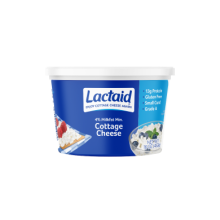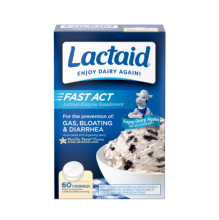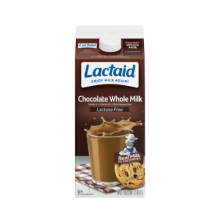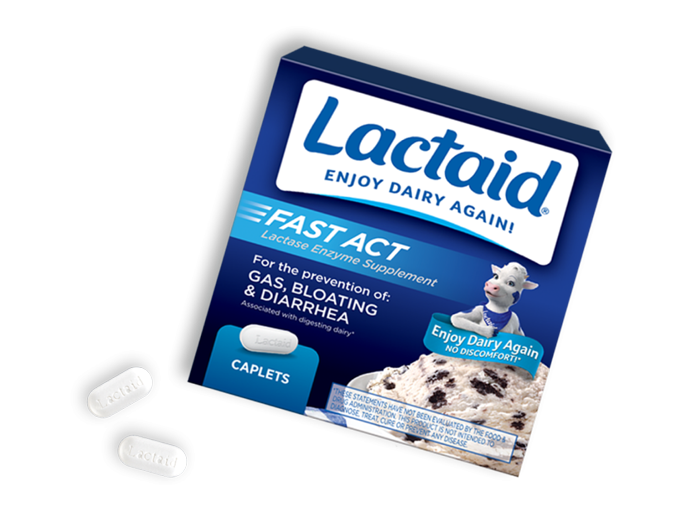Enjoy dairy whenever and wherever with our supplements.
Just take with your first bite to help prevent discomfort associated with digesting dairy.
DISCOVER SUPPLEMENTSWondering what foods to avoid and what to eat if you’re lactose intolerant? You’re just in luck. Don’t give up the foods you love. With these lactose intolerance diet tips, you can still enjoy the delicious taste and nutrition of dairy, minus the discomfort.
Did you know that lactose is naturally found in milk and dairy? This also means that it can be found in many common ingredients and additives in certain foods. Since we all have different levels of lactose sensitivity, foods containing lactose are generally classified into two groups:
These foods contain high amounts of lactose, about 4-12 grams per serving. Common high lactose foods you might come across while grocery shopping include:
FOOD & BEVERAGES |
SERVING |
LACTOSE (GRAMS) |
|---|---|---|
| Milk | 1 cup | 9 - 12 |
| Buttermilk | 1 cup | 9 - 12 |
| Fat free dry milk | ⅓ cup | 12 |
| Goat milk | 1 cup | 9 |
| Ice cream | ½ cup | 6 - 9 |
| Cheese spread | 2 ounces | 5 - 8 |
| Non-fat dry milk powder | 2 tablespoons | 5 - 8 |
| Heavy Cream | ½ cup | 5 - 8 |
| Yogurt, low fat | 1 cup | 5 |
| Condensed milk, whole | 2 tablespoons | 4 |
FOOD & BEVERAGES |
LACTOSE (GRAMS) |
|---|---|
|
Milk SERVING 1 cup |
9 - 12 |
|
Buttermilk SERVING 1 cup |
9 - 12 |
|
Fat free dry milk SERVING ⅓ cup |
12 |
|
Goat milk SERVING 1 cup |
9 |
|
Ice cream SERVING ½ cup |
6 - 9 |
|
Cheese spread SERVING 2 ounces |
5 - 8 |
|
Non-fat dry milk powder SERVING 2 tablespoons |
5 - 8 |
|
Heavy Cream SERVING ½ cup |
5 - 8 |
|
Yogurt, low fat SERVING 1 cup |
5 |
|
Condensed milk, whole SERVING 2 tablespoons |
4 |
These foods get the green light for their low lactose levels (less than 3 grams per serving). Some common low lactose foods you might find in the grocery store include:
FOOD & BEVERAGES |
SERVING |
LACTOSE (GRAMS) |
|---|---|---|
| Evaporated milk | 2 tablespoons | 3 |
| Cottage cheese | ½ cup | 2 - 3 |
| Sherbert | ½ cup | 2 |
| Cheese: american, swiss, blue | 1 ounces | 1 - 2 |
| Cheese: cheddar, parmesan | 1 ounces | 1 - 2 |
| Cream cheese | 1 ounces | 1 - 2 |
| Half and half | 2 tablespoons | 1 |
| Light cream | 2 tablespoons | 1 |
| Sour cream | 2 tablespoons | 1 |
| Whipped cream | 2 tablespoons | < 1 |
| Butter, margarine | 1 tablespoons | traces |
FOOD & BEVERAGES |
LACTOSE (GRAMS) |
|---|---|
|
Evaporated milk SERVING 2 tablespoons |
3 |
|
Cottage cheese SERVING ½ cup |
2 - 3 |
|
Sherbert SERVING ½ cup |
2 |
|
Cheese: american, swiss, blue SERVING 1 ounces |
1 - 2 |
|
Cheese: cheddar, parmesan SERVING 1 ounces |
1 - 2 |
|
Cream cheese SERVING 1 ounces |
1 - 2 |
|
Half and half SERVING 2 tablespoons |
1 |
|
Light cream SERVING 2 tablespoons |
1 |
|
Sour cream SERVING 2 tablespoons |
1 |
|
Whipped cream SERVING 2 tablespoons |
< 1 |
|
Butter, margarine SERVING 1 tablespoons |
traces |
Thankfully, you can still enjoy your favorite dairy products by making a few changes to your diet. Let’s look at five, hassle-free, low-lactose diet tips to kickstart your diet plan today.
Don’t stress your gut. Eat dairy with other foods like fats and proteins to slow down the digestive process and minimize the symptoms of lactose sensitivity 2 . You can spice up your meals by adding milk to your pancake recipe, cheese to your lasagna, or even fry your salmon with ghee.
If you’re a big fan of cheese, you’ll be pleased to know there are ways to enjoy it, even if you’re lactose intolerant! The trick is to go for hard cheeses like Parmesan, Swiss and Cheddar because they contain low amounts of lactose, unlike soft cheeses like cream cheese or ricotta 3 . Still craving a soft cheese to enjoy? Try LACTAID® Cottage Cheese on your next cheeseboard for a smooth and creamy taste, without the discomfort.
Simply being mindful of your dairy can help you manage your lactose sensitivity symptoms. Start by reducing the amount of dairy you consume – and then gradually reintroduce it in small amounts together with other foods. Your goal is to find that sweet spot on how much lactose your body can stand.
Did you know that people with lactose intolerance can often still eat yogurt? Probiotic yogurt is easier to digest than other types of dairy thanks to its active cultures 4. This makes yogurt the perfect dairy snack or ingredient for cooking. Keep in mind your tolerance may vary depending on the type you choose.
Another option is to simply switch from low-lactose dairy options to lactose-free dairy products. Browse our variety of LACTAID® products that give you the power to enjoy the taste of real dairy, just minus the lactose. You can also substitute lactose-free alternatives for regular dairy in your favorite recipes.
Stay on the safe side when grocery shopping by checking the labels of any food products you buy. You might be adding lactose to your diet without even realizing it. Here are some common food ingredients to avoid if you are lactose intolerant 5:
Some foods containing an unexpected amount of lactose include:
NOTE: The below ingredients might look like they contain lactose because of the way they are spelled, but they are surprisingly lactose-free:
Going totally without dairy might do your diet more harm than good, as you’ll be missing out on the essential nutrients milk provides.
Remember that milk also contains essential nutrients like calcium – which is vital for maintaining strong bones and teeth. Milk also contains protein and essential vitamins, like vitamin D and B12, that are key for a well-functioning nervous and immune system 6 .
If you’re still having issues with dairy, you can add these lactose-free, non-dairy foods to your diet to get as much calcium and key vitamins as possible:
Sardines, salmon and tuna – Oily fish like sardines are rich in calcium and vitamin D which can supplement the calcium lost by eating less dairy.
Broccoli (cooked) – Broccoli contains high amounts of calcium and is also packed with Vitamin C, B6 and D.
Tofu – This vegan superfood is high in protein, fiber, calcium and vitamins A, B1 and E.
Spinach (cooked) – Spinach is a calcium rich food, it also contains high amounts of Vitamin D, B6 and C (Lactose intolerance, 2022).
Nuts (including nut butters) and seeds – Almonds, pine nuts, sunflower seeds, sesame seeds, walnuts and cashews are rich in nutritional protein and healthy fat 7 .
Legumes and beans – All beans, lentils, chickpeas and split peas are a healthy alternative to dairy-derived proteins and vitamins.
There are still many ways to enjoy your favorite dairy products even if you’re lactose sensitive. From low-lactose dairy to plant-based alternatives, here are some of the ways to enjoy dairy and still feel great.
Hard cheeses like Parmesan and Swiss are great alternatives to soft cheeses like cheddar because they contain small amounts of lactose.
While Ghee and butter are both low lactose dairy options, ghee contains a significantly lower amount of lactose.
Using plant-based alternatives to common dairy products can help manage your symptoms. Try things like nutritional yeast, oat-milk and coconut yogurt as a ‘dairy’ alternative to things like cheese, milk and regular yogurt.
If you just don’t want to give up your favorite dairy foods like cheese and ice cream, LACTAID® supplements help break down lactose so that you can savor the sweet taste of dairy anywhere, anytime, without the discomfort.
Using lactose-free dairy is a great way to add the nutritious benefits of dairy products while avoiding the lactose. Choose from our wide selection of lactose-free LACTAID® products and continue to enjoy the delicious taste of dairy.
Spice things up in the kitchen and follow our LACTAID® dairy recipes to create delicious lactose-free meals right in your home.
Butter contains a small amount of lactose that may not trigger symptoms of lactose intolerance. However, talk to your physician first before adding butter to your low-lactose diet.
Goat milk is a natural dairy product and therefore contains nearly as much lactose as regular cows milk. Goat cheese is made from goat milk and also has lactose.
The age of a cheese plays an important role in determining how much lactose is present. An aged (hard) cheese like parmesan has smaller amounts of lactose compared to a young (soft) cheese like mozzarella . That’s because soft cheeses contain more whey, which has lactose.
Parmesan is a hard cheese that contains lactose in small quantities. It’s a great alternative for people who love cheese but are lactose sensitive.
Eggs do not contain lactose and are suitable for a low-lactose diet.
Just like goat and cow milk, sheep milk is a natural dairy product and contains lactose.
Some chocolate products contain lactose, like milk chocolate. But vegan and dairy-free chocolate does not. Be sure to check the nutrition label first as some chocolate is dairy-free but still contains a small amount of lactose. You can also try our LACTAID® chocolate milk that’s got that delicious chocolatey flavor you love, minus the discomfort.
If you’re completely unable to tolerate dairy because of a reaction to the dairy proteins found in milk, you should go for dairy-free alternatives like almond milk and soy milk.
Don’t see your question? Visit our FAQs page.
SEE ALL FAQS
LACTAID® Cottage Cheese

LACTAID® Fast Act Chewable Lactase Enzyme Supplements

LACTAID® Lactose-Free Chocolate Milk
Total Time: 45 min
Total Time: 20 min
Total Time: 5 min
Total Time: 2 hr, 20 min

Just take with your first bite to help prevent discomfort associated with digesting dairy.
DISCOVER SUPPLEMENTS